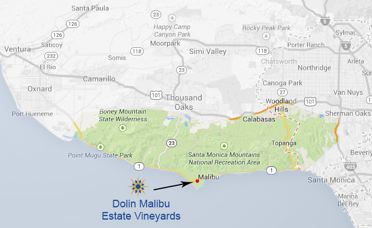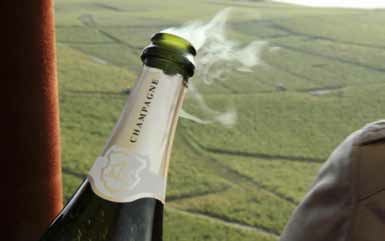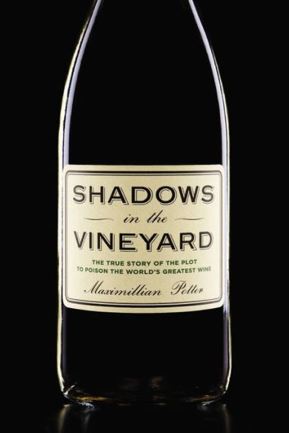Pinot Briefs
—Newsletter 9.44
Malibu Coast Receives AVA Status 52 winegrowers became classified as part of the official Malibu
Coast American Viticultural Area in July. Elliott Dolin, proprietor of Dolin Malibu Estate Vineyards, helped to
initiate the 3-year process. Few people are aware that the wine grape growing history in the Malibu area goes
back two centuries. The region is about 46 miles long and 8 miles wide, composed mainly of the Santa Monica
Mountains with 198 acres of vines in production. Elevations range from sea level to 3,111 feet a top Sandstone
Peak. The coastal, Mediterranean climate heavily influences the region, offering a large diurnal shift from day
to night, with warm, dry summers and cool, moist winters. The most widely planted varieties are Cabernet
Sauvignon, Syrah, Merlot and Chardonnay with a smattering of Pinot Noir. The Malibu Coast AVA is also home
to two previously established AVAs, Saddle Rock Malibu and Malibu-Newton Canyon.

WineGlass for iOS Uses iPhone to Rate Wines on Wine List WineGlass is an app that allows
you to take a photo of the wine menu with the iPhone camera and WineGlass then scans the wine list, pulls up
the individual wines using the Cellar Tracker database containing over 4 million tasting notes, and reveals wine
reviews, tasting notes, food pairings, and expected price. The app was developed by Facebook veteran Roddy
Lindsay and works on most wine menus. WineGlass for iOS is available for $4.99 from www.itunes.apple.com.
Chehalem Mountain Winegrowers Origin ’14 A food and wine event set in the vineyard at
Arbor Brook Vineyards, Saturday, August 9, 2014, 4:30 to 8:00 PM. This is a chance to meet the characters
behind the 27 participating wineries, walk among vines and vineyard blocks, and feast on food from Bamboo
Sushi, The Bent Brick, Cha Cha Cha, The Painted Lady and Subterra. $60 per person. For tickets, visit
www.chehalemmountains.org.
Shipping Wine in Summertime is a Challenge This time of year it is so warm in parts of the
country, such as Orange County, California, where I live, it is impractical to ship wine unless it is transported by
refrigerated carrier (FedEx and UPS offer this in California) or shipped overnight (not always a guarantee that
the wine will be delivered the following day). If wine is exposed to heat, it undergoes rapid oxidation and
spoilage. I have met with several damaged bottles already this summer. ACH Foam Technologies’ WineLoc®
is a shipping method that guarantees a shipment is protected at or below 80ºF for 72 hours (this concerns me
as 80ºF is pretty hot for wine, particularly if it remains at this temperature for 2 to 3 days. The company’s
summer wine shippers keep the wine inside at a constant stable temperature for approximately 72 hours. 2-,
6-, and 12-pack EPS foam units are contained within an outer corrugated box and use specially designed
pockets that hold frozen gel refrigerants that allow internal airflow while protect the wine labels from damage
during transit. The shipping containers are the first EPS packaging made of 60% or more recycled content. I
have not received a wine shipment using this technology. Visit summerwhieshipper@achfoam.com.
New Documentary ‘A Year in Champagne’ The second move in the series (the first was ‘A Year
in Burgundy,’) has been acquired by Samuel Goldwyn Films, the distributor that turned the film ‘SOMM’ into a
sensation. Writer and director David Kennard’s followup movie boasts many revelations about Champagne.
The star of both films is Martine Saunier, who acts as a guide, leading a rare glimpse behind the scenes into
six Champagne houses including Gosset and Bollinger. The movie has already screened to audiences at the
Santa Barbara and Palm Beach International Film Festivals and the documentary is scheduled for an early
spring 2015 release.

Plot to Poison the World’s Greatest Wine Revealed in New Book Journalist Maximillan
Potter wrote this book in cooperation with Domaine Romanee-Conti’s owner Aubert de Villaine. It details the
failed attempt to ransom the DRC estate by poisoning its vines. Titled, Shadows in the Vineyard: The True
Story of a Plot to Poison the World’s Greatest Wine,” the book relates how Jacques Soltys poisoned two vines
with herbicide in an attempt to extort money from the estate before he was caught in a police sting operation.
Soltys committed suicide while awaiting trial. Potter also delves into the history of the domaine, the history of
wine fraud, and property ownership in Burgundy.

2014 Wine Blog Awards I was one of the judges, that along with the public, votes on the annual Wine
Blog Awards. The winners were awarded at the recent Wine Bloggers Conference in Santa Barbara County.
Highlights: Best Industry/Business Wine Blog - Tom Wark’s Fermentation: The Daily Wine Blog; Best Wine
Reviews on a Wine Blog - Wine School of Philadelphia; Best Winery Blog - The Lynmar Life; Best Writing
on a Wine Blog: HoseMaster of Wine; Best New Wine Blog - Girl and the Grape; and Best Overall Wine Blog
- Jamie Goode’s Wine Blog.
An Analysis of Wine Critic Consensus The Journal of Wine Economics, published by the
American Association of Wine Economists (AAWE), recently released AAWE Working Paper No. 160: “An
Analysis of Wine Critic Consensus: A Study of Washington and California Wines” (Eric T. Stuen, Jon R. Miller
and Robert W. Stone). The research looked at the degree of consensus in quality ratings among prominent
wine publications including Wine Spectator, Wine Enthusiast, Wine Advocate, and International Wine Cellar.
The authors found ample critical consensus between the four publications. Consensus was not found to be
related to the blinding policies (or lack thereof) of the critical publications. The findings, which involved
matched ratings of 401 wines, showed that quality ratings have a substantial degree of objectivity to them.






